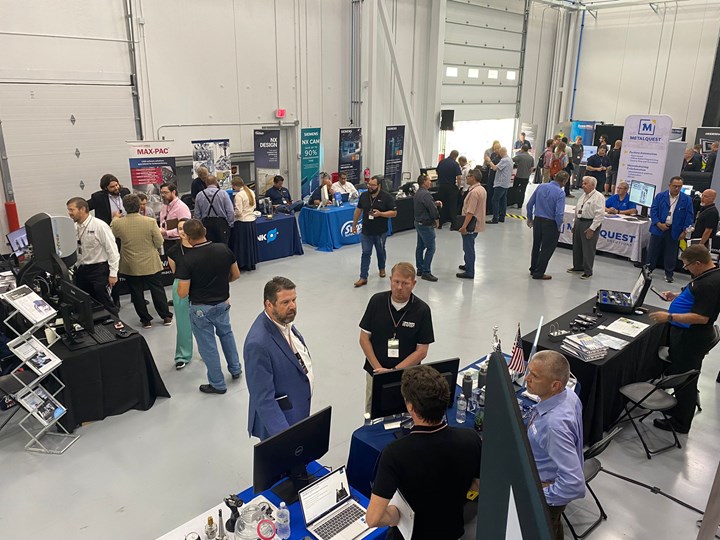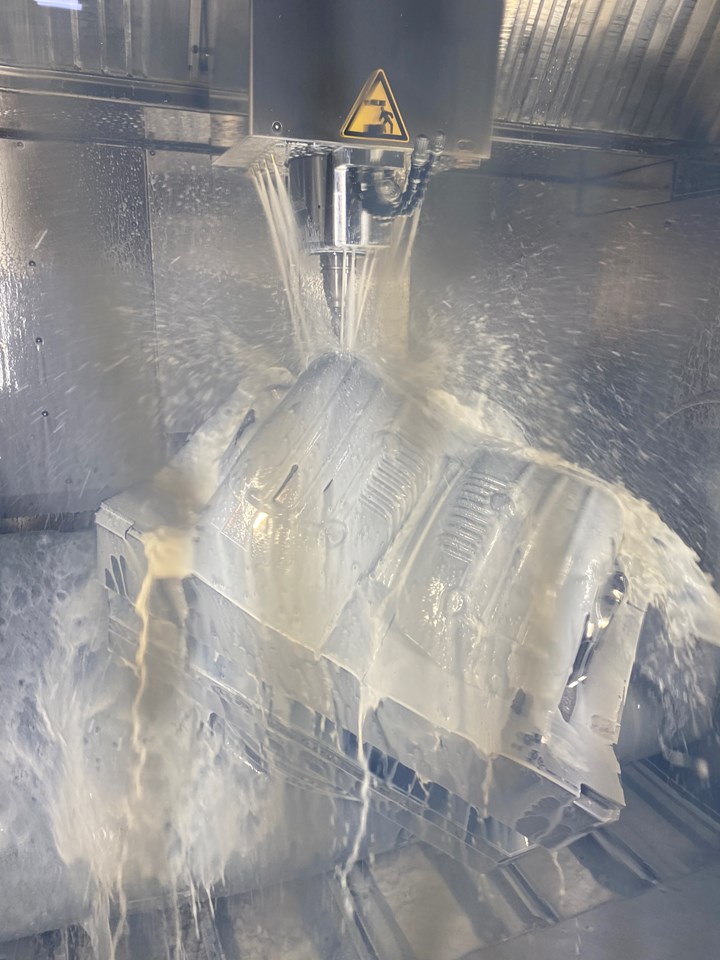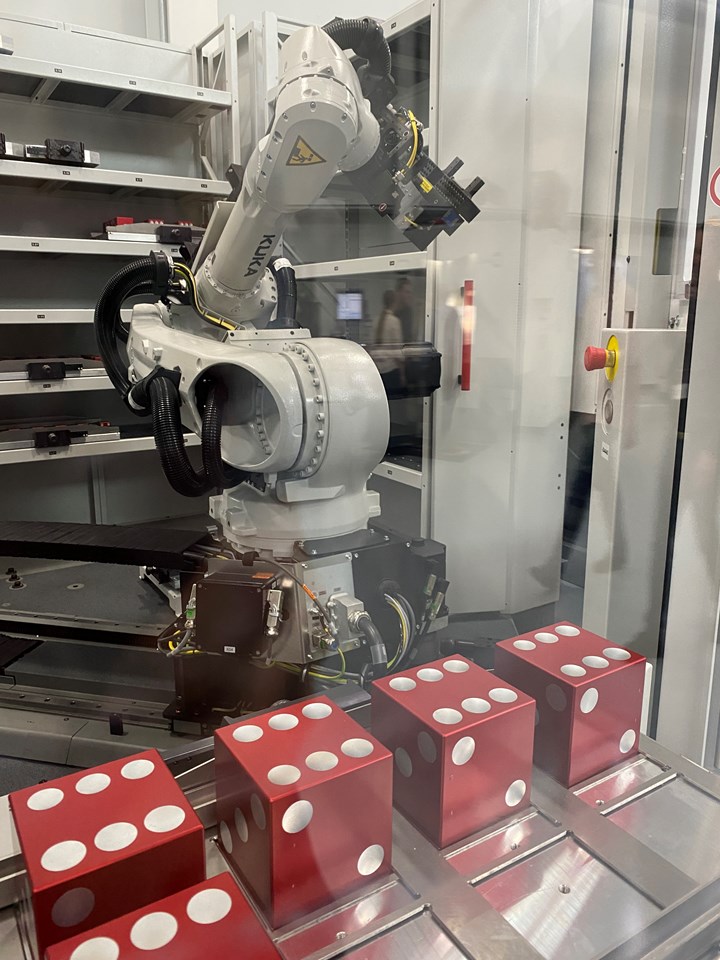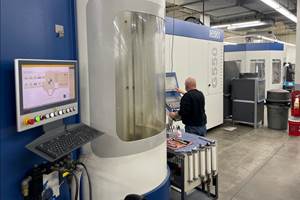Share


Shops may have once thought five-axis machining is too complicated or unnecessary for their business, but as parts become more complex and shops are challenged to produce more parts with fewer people, interest in five-axis machining is soaring. “I think it's the right time for us to be good stewards of our customers and good stewards of five axis,” says Cullen Morrison, regional sales manager at Hermle. The five-axis machine tool supplier held its first Five-Axis Summit October 3-5 at its North American headquarters in Franklin, Wisconsin, which it intends to hold going forward in non-IMTS years.

Hermle’s Five-Axis Summit included presentations on various five-axis topics ranging from controls to part planning to automation. Photo Credit: Moon Landing Agency
The company’s goal was to create an event that was more than an open house — it wanted to educate users of five-axis machining at all experience levels. This was reflected in the summit’s technical agenda, much of which was designed to be agnostic to machine tool brand. It also included seven machine demonstrations on the showroom floor, along with participation from 30 partners representing tooling, workholding, software and other peripherals crucial to the success of five-axis machining.

The event included participation from 30 of Hermle’s partners in five-axis machining, representing software, controls, tooling, workholding and inspection equipment. Photo Credit: Moon Landing Agency
Beginner Basics
One of the biggest misconceptions potential users have about five-axis machining is that it’s difficult to use. While full simultaneous five-axis motion might be more complex than three-axis machining, this doesn’t represent most work that runs across five-axis machines, says Markus Puntigam, vice president of sales and marketing at Hermle. Instead, 3+2 machining is the more common and easier option. A 3+2 machining application was included among the demos on the showroom floor at the event.

Hermle had seven machine demos on its showroom floor, which included both 3+2 and full five-axis simultaneous motion.
Job shops may also think they don’t need five-axis, but Morrison encourages a different perspective. “For a lot of companies, five-axis will be their next greatest jump to profitability,” Morrison says. It can help shops become more efficient and more competitive.
This was the mindset of attendee Dylan Jackson, CEO and programmer at Proteum Machining. His quick-turnaround prototyping shop uses three- and four-axis VMCs, but doesn’t yet have a five-axis machine. “We've kind of realized that is where we need to be for a lot of our customers,” he said. “We get asked all the time for five-axis-style parts.” In addition to increasing the complexity of parts Proteum can produce, five-axis machining promises to help reduce setup times, which is crucial for a small shop like his. “Anything we can do to cut down the number of setups and the amount of setup hours is really what we need,” he noted.
Proteum has already taken steps to prepare for a five-axis machine, including implementing Lang workholding and PowRgrip toolholders from Rego-Fix (two of the partners present at the event). Jackson notes having a sustainable plan to adopt these technologies is important, because a five-axis machine and all of the necessary peripherals are a lot of money (and a lot of changes) to implement at once. Buying the tooling and workholding in advance of the machine has enabled him to gain experience and decide what works and doesn’t work before investing in the machine.
Advancing With Automation
When asked what shops with five-axis machines could do to take their capabilities to the next level, Morrison was quick to mention automation. Automation isn’t just for high-volumes, he noted — it can work for batches and single pieces as well. Three of the seven machine demos on the shop floor were fully automated, each using one of Hermle’s automation systems: the HS Flex/HS Flex Heavy pallet system; the RS 05 robotic cell; and the RS 1, which incorporates a robotic arm that can handle both pallets and parts directly for maximum flexibility. “All the automation cells we offer come directly from the same factories,” Puntigam explained. “We make the machines, we make the automation cell, and we also develop the software communicating between the automation cell and the machines. So it works seamlessly together and we don't have any third-party interface.”

Three of the seven machine demos included automation, including Hermle’s RS 1 system, which can handle both pallets and individual parts thanks to its flexible grippers.
Automation is also part of Proteum’s long-term plans for five-axis machining. “I think that five-axis really lends itself to automation, specifically pallet loading automation,” Jackson said.
According to attendee Gail Plush, a manufacturing engineer at Rolls Royce, his facility has been using five-axis machines since before he joined in 2009, and has been using Hermle specifically since 2016 to make turbine discs. The facility’s customized automation solution includes pallet pools, extended tool changers and sensors that measure a variety of features (fixture pressure and RPM) to provide data to the operator. Based on the facility’s current success, he foresees the company adding more pick-and-place pallets, as well as systems to auto-identify parts using RFID chips and probes. “We're constantly advancing, mainly through measurement cycles, technology cycles and automation,” he said.
Related Content
How to Succeed as a Small Swiss Shop: Top Shops 2025
Can small shops succeed with advanced machine tools and software? If so, how do they do it? Read on to learn the strategies that have helped Midway Swiss Turn, our 2025 Top Shops Honoree in Shopfloor Practices, thrive.
Read MoreFive-Axis Turnkey Machine Halves Medical Shop’s Cycle Times
Horizontal five-axis machines cut cycle times in half at ARCH Medical Solutions – Newtown. But its leadership gives equal credit to a surprising factor: the OEM’s service department.
Read MoreResults-Driven Innovation on Display at Mazak's DISCOVER 25
DISCOVER 25 attendees will enjoy keynotes and panel presentations, and have a chance to tour the Mazak iSMART Factory where the company “uses Mazaks to make Mazaks.”
Read MoreUsing Automation to Reduce COGS and Stay Globally Competitive
Decade-long, multiphase automation investments lower operating costs and maintain technology lead in an increasingly competitive global market.
Read MoreRead Next
OEM Tour Video: Lean Manufacturing for Measurement and Metrology
How can a facility that requires manual work for some long-standing parts be made more efficient? Join us as we look inside The L. S. Starrett Company’s headquarters in Athol, Massachusetts, and see how this long-established OEM is updating its processes.
Read More





























